-
HONEYLAND/ Медена Земја (Tamara Kotevsk, Ljubomir Stefanov 2018)
TAMARA KOTEVSK, LJUBOMIR STEFANOV: HONEYLAND/ Медена Земја (2018)
Review originally published for New Directors/New Films (Apr. 3 & 5)
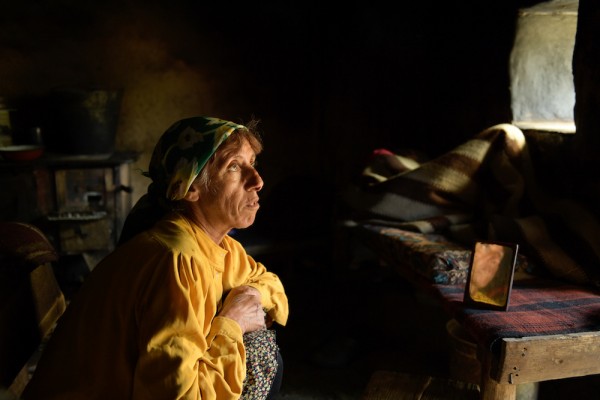
HATIDZE MURATOVA IN HONEYLAND
No matter how remote, your environment is in danger
Austere but rich, Kotevsk and Stefanov's Honeyland is one of the most immersive and atmospheric documentaries you will see this year. No narration is necessary. This film has only the limitation of its restrictive life. At the center of it, living in an abandoned Macedonian village, is Hatidze or Atidze Muratova, a small, tough birdlike woman of 55 with an easy smile, lined face, and big crooked teeth who tends her bee colonies with expertise and respect and her mother, with whom she lives, out of love and duty. Her mother Nazife is 85, not planning on dying, "just making your life misery," she says, declaring she's become a tree. She is half blind and does not stretch or go outside.
Hatidze is busy. What she does is wild beekeeping, or bee hunting, in hives she finds behind slabs of stone. Her easy skill with bees is clear, her respect for the sustainability of her task. She removes the combs like books from a shelf, easily, gently. She is cooperative, non-invasive. Look how she is with her skinny graceful dog at the very end of the film. She has a knack for nature that's almost elegant. She is good also with people, trading fairly and confidently to shopkeepers in the market in the capital, Skopje, touting the healthy and medicinal quality of her honey. Hatidze is a good person.
What a bare life this is. Comforts are dye for Hatidze's hair, tying it up with a nice scarf with rocky village chic, favoring yellow and green, a fan for her mother, and a little transistor radio hooked up once to a small speaker atop a pole she tries to broadcast music, but she gets only snatches of a song here or there. Herself, she sings. She cries and calls and sings to the bees when when she is working them.
The film is the result of three years of shooting by this team. As will happen with diligent documentarians, the reward of a significant event arrives: new neighbors appear with a dinky, antique trailer, seven unruly kids, and a bunch of calves. The man, Hussein Sam, takes up bee keeping too, but despite Hatidze's advice, never learns the way of it, or will not, because he is greedy for instant rewards and has not the necessary patience and respect that nature requires. We learn from Hatidze that you take half the honey and leave the other half to the bees. This maintains the balance. Take too much, and the bees will die, or attack Hatidze's bees. Sam takes too much, and both things happen.
One of the boys bonds with Hatidze. He understand them and respects her way with them. "If I had had a son like you. . . " she says. But his family doesn't understand the balance. But the neighbors are a nightmare. They are lazy and quarrelsome and the do serious damage. Their rampages cause the destruction of a lot of Hatidze's bees, their own, and, finally many of their young calves die due to the fat wife's carelessness. All goes wrong, angering even Hatidze's quiet mother. "May God burn their livers" is one of her last declarations. And then, after all their damage, they pick up and leave. Perhaps nature will regain its equilibrium again somehow. At the end, Hatidze's seen looking forward, alone, hopeful, strong.
This simple film is nonetheless superb and hard to improve upon. Kudos to the cinematography of Fejmi Daut and Samir Ljuma with its naturally gorgeous compositions of rocky hillside, animals, and ruined village architecture, the deep color of the clothes and gnarly skin in the market, the clear natural light. Much respect also to the filmmakers Tamara Kotevsk and Ljubomir Stefanov for their personal human sense of the observational documentary style, which makes this film so memorable.
Honeyland, 85 mins., debuted at Sundance (reviewed there by Guy Lodge for Variety and by Shiri Linden for Hollywood Reporter). Reviewed for New Directors/New Films, now showing in the San Francisco Film Festival.
SFFILM showtimes:
Sat, Apr 20 at 1:30 pm - BAMPFA- AT RUSH!
Fri, Apr 19 at 6:00 pm Victoria Theatre - AT RUSH!

HATIDZE MURATOVA IN HONEYLAND
Last edited by Chris Knipp; 04-12-2019 at 05:43 PM.
-
IN MY ROOM (Ulrich Köhler 2018)
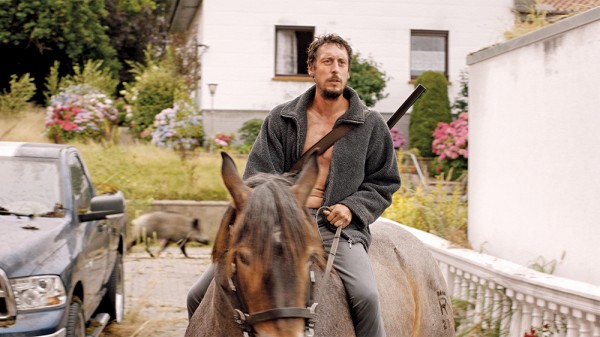
HANS LÖW IN IN MY ROOM
Muddling toward heroism
While I had trouble getting a grip on Köhler's previous film, the 2011 Sleeping Sickness (NYFF), this everyman-in-the-apocalypse tale, inspired, the director says, by three books,* goes down very easy, strange though it is. And after all, you want a last-man-living tale to be strange; otherwise why bother to make another one? We're with the Berlin School here, and Köhler's wife is Maren Ade, whose Toni Erdmann was one of the School's films recently celebrated at Cannes, as was this, and Valeska Grisebach's Western. These have all been included in NYFF's, by the way.
What's fresh here to start off with in the first of three segments, the slouchy protagonist, Armin (Hans Löw), doesn't do things that are going to seem meaningful or ironic when he wakes up and there's no living other soul on earth to be found. He's a tall, slightly slobby boychild, approaching middle age but a flop as a freelance TV cameraman covering local politics. He's so bad, the wittily absurd opening segment is a lengthy clip of jerky footage where he was confusing the "on" and "off" buttons of his telecamera and would up turning it off when the politicians gave their speeches and on when nothing was happening. He seems to make the dance club scene and he fails miserably to stage a one night stand with a lady his age. No wonder: he's a slob.
Armin takes a break (an autobiographical moment, Köhler has said) in the country helping his father take care of his dying, bedridden grandmother. Köhler delivers an almost alarming degree of banality-plus-specificity throughout all segment. It also goes on a tad too long by the standards of setups for conventional sci-fi apocalypse tales. This heightens our sense of the banality, and the suspense (assuming we know the genre we're watching).
Then comes the middle section, with its stunning leap. After Armin wakes up and can't find anybody alive, he flails aroudnd for a while, exploring empty shops, breaking into grandma's house. Her corpse is there and he finds a radical solution to that. He gets drunk. Most notably, he has an inspiration and a solitary moment of grand wildness. He steals a Lamborghini painted with racing insignias and drives at breakneck speed through all the winding streets of the town dodging scattered cars. Here production designers Jochen Dehn and Silke Fische excel, providing a wealth of motorcycles on highways scattered like dead beetles, big trucks diagonally abandoned, all sorts of signs of sudden disappearance of humanity.
The film gets a shot of adrenaline with its little sudden jump forward to Robinson Crusoe Armin, pot belly gone, tan and buff and flat-bellied, out at a farm he has set up in what he later explains is the area where he grew up, with livestock, chickens and a horse and at work on setting up a hydroelectric generator on a local stream, though somewhat inexplicably, there seems to still be water and light freely available from the usual public supply. Now, Armin not only looks good. He has a purpose in life, and seems happy. Just as Köhler reveled in his protagonist's humdrum urban quotidian, he now delights in the classic gestures of self sufficiency in nature. And this is obviously a choice. Armin could have survived on the edge of leftover civilization, off the abundance of consumable products, off canned food. But no. He will dig up potatoes, raise hens, shoot game.
In the last segment, Kirsi (carefully chosen Italian actress Elena Radonicich) appears, driving a small camper. Though Armin still has a car, he seems to prefer cultivation and travel via his trusty workhorse. She's attractive. And now, Armin is attractive too, both in his physical looks and in the machismo of his functionality in this new world. So here they are, Adam and Eve, and they look good. But of course it doesn't turn out that way. Köhler has said he chose Radonicich because she seemed like a woman who has lived alone independently for five years. They have sex, plenty of it. But when Armin suggests they make a baby, Kirsi balks. "Would you want to bring a child into this world?" she asks. "I love this world," he answers (a wonderfully resonant line, richer than it looks in print). "You don't," Kirsi says, "you just love fucking!" So gradually ends the idyll.
The New York Film Festival blurb last fall spoke of this film's "meticulous details and sly, subtle ironies," and its the interplay between the two that makes this a fresh and resonant work. It's also essential somehow that most of these Berlin School films tend to go on "too long." They create their own real time pace, as was notably the case with Maren Ade's Toni Erdmann. I have the feeling that I missed the point of Sleeping Sickness, an essence the judges got at Berlin that year to award it the Silver Bear. Here, I'm pretty sure rewatching would yield plenty of awards. The main actors are very interesting.
__________
*He has cited Arno Schmidt's Black Mirror, Marlen Haushofer's The Wall, and David Markson's Wittgenstein's Mistress as inspirations.
In My Room, 119 mins., debuted at Cannes Film Festival (Un Certain Regard) 17 May 2018, and showed in at least a dozen other festivals including Karlovy Vary, Munich, Jerusalem, New York, Busan, Göteborg, Rotterdam, and San Francisco, as part of which it was screened for this review.
SFFILM showtimes:
Sat, Apr 13 at 8:15 pm BAMPFA
Sun, Apr 14 at 8:00 pm SFMOMA Wattis Theater
Last edited by Chris Knipp; 03-22-2023 at 02:00 PM.
-
THE LOAD/TERET (Ognjen Glavonić 2018)
OGNJEN GLAVONIĆ: THE LOAD/TERET (2018)
(Originally published for New Directors/New Films)
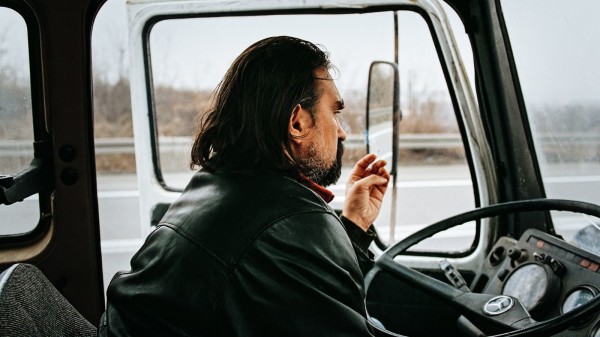
LEON LUČEV IN THE LOAD/TERET
A Serbian trucker's grim ride: a stoical look at an ambiguous journey
This atmospheric, wintry road movie by Ognjen Glavonić concentrates on a truck driver who must convey sensitive cargo along a treacherous path, from Kosovo to Belgrade during the 1999 NATO bombing of Yugoslavia. Reference to Henri-Georges Clouzot’s classic Wages of Fear of Friedkin’s remake Sorcerer is obvious but so is the difference: this driver has an unknown load, and papers permitting him to pass without opening it up to authorities. This is not a high tension journey with deliciously unbearable suspense, but rather one of slow, brooding, tedious nerve-wracking-ness and the growing sense that Vlada (Croatian actor Leon Lučev), the driver, has gotten involved in some unspecified but considerable evil. The oblique but insistent reference is to an atrocity, a late Kosovo war massacre, that Glavonić meticulously documented earlier in his 2016 non fiction film, Depth Two. Ognjen Glavonić is a person in intense pursuit of secrets his countrymen want to forget.The director has said "every country is built on crimes that they don’t want to talk about." The load: the very burden Vlado carries is weighted down with metaphorical conceit that, despite the minimalism of the style, feels lugubrious and heavy-handed.
On the journey not much happens but each small incident is magnified. Vlada picks up a young hitchhiker (Pavle Čemerikić) on his way to Munich. He stops to rest several times. He telephones to his wife, who's having hospital tests. He gets his cigarettes and what turns out to be a historic lighter stolen during a brief absence from the truck. The camera briefly leaves Vlada, following the hitchhiker to an abandoned playground where his name is painted (a goodbye to his youth, perhaps?) watched two young petty thieves examine the stolen lighter.
At the end of the film, Vlada meets with his son, Ivan, and tells him a wartime grandfather Leka cigarette lighter story that's less colorful, but may remind you of the gold watch story told by Captain Koons (Chris Walken) in Pulp Fiction. In a Film Comment interview with Eric Hynes, Glavonić says everything must lead up to the father's opening up to his son in this sequence. A nice touch, the walnut tree that grew out of the fallen Leka's pocket. There was actually a medal, a watch and a lighter awarded posthumously to Leka after WWII.
The ending is hopeful, with the teenage Ivan liking his dad's "friend's" band tape and sharing with his sister the thought that he needs to form a band of his own. But he won't escape the burden of these days he doesn't yet know about - not if Ognjen Glavonić has anything to say about it.
The Load/Teret 98 mins., debuted at Cannes in Directors Fortnight May 2018; over 1 5 other festivals including Toronto, Vancouver and Rotterdam. Reviewed at Cannes by Jessica Kiang for Variety (she calls this feature debut "harshly intelligent and uncompromisingly spare"), and by Stephen Dalton for Hollywood Reporter. Dalton comments pointedly that this film "should find a keen audience among the the misery-porn masochists who program and attend film festivals," but will be only "very niche commercial prospect, especially for non-Balkan viewers." A pessimistic view of a well-crafted film in which, indeed, not enough finally happens. Screened for this review as part of the 2019 MoMA-FSLC New Directors/New Films Series.
Now showing as part of the 2019 San Francisco Film Festival.
SFFILM showtimes:
Thu, Apr 18 at 6:00 pm - Roxie Theater
Sun, Apr 21 at 6:00 pm - BAMPFA
Mon, Apr 22 at 3:30 pm - Victoria Theatre
Last edited by Chris Knipp; 04-15-2019 at 07:21 AM.
-
LORO (Paolo Sorrentino 2018)
PAOLO SORRENTINO: LORO (2018)
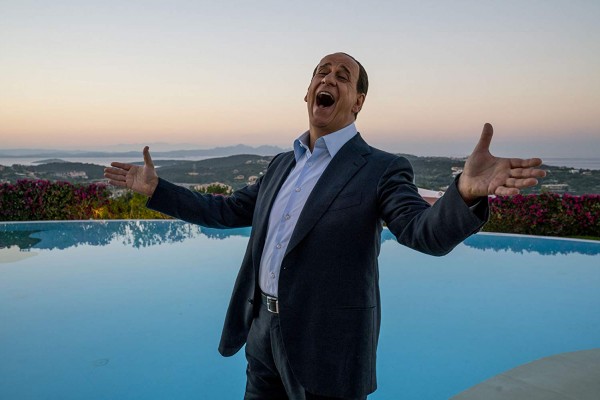
TONI SERVILLO IN LORO
Berlusconi squared
So here it is, Paolo Sorrentino's latest masterpiece, a feat of glorious filmmaking, and it's a grotesque portrait of Silvio Berlusconi, the ultra-rich, charming, crooked several-time PM of Italy, who's currently jockeying for reentry into the corridors of power in Italy, surrounded by scandals and crimes and eighty years old. And this is another incredible performance in the lead role by Sorrentino's long-time collaborator, Toni Servillo, and one of his most amazing. It may rival his work in the earlier Il Divo and The Great Beauty/La grande bellezza.But this is a "visceral, grotesque and graphically vulgar portrait" of Berlusconi (Deborah Young, Hollywood Reporter).
I love he texture scene-to-scene of this extravaganza, which is every bit up to the standard of the director's previous efforts. But it's also a a bit of a mess, or arguably, giving its ambition, a big mess. To begin with, there were two parts, Loro I and Loro Ii, and this is a blend and a reduction, resulting, in the view of some, in an augmentation of the worst aspects of each of the two parts (Deborah Young thinks so). There is also the moral issue, or the point of view. Like that tasteless critique of tasteless wealth, Crazy Rich Asians, this is a movie in love with the very things it set out to criticize. Secondo Deborah, this truncated version clarifies each of the two main narrative threads, Berlusconi's breakup with his wife of 26 years, Veronica Lario (played by Elena Sofia Ricci), vs. the effort of a businessman, Sergio Morra (Riccardo Scamarcio, excellent) to line up "il presidente" with a bunch of bikini-clad, coke snorting champagne quaffing young ladies - a crass modern seraglio, in effect a specialized custom prostitution ring. But at the same time the shorter version only underlines that these two don't have much to do with each other and the movie as a whole isn't going anywhere.
I'd also like to comment on the frequent linking of Sorrentino with Fellini, who's said to be his inspiration and master. Fellini may have lived in better times. But Fellini would not make a movie anything like this. He created fantasies, full of inspiration and personal style. His work is fundamentally brimming with humanity. Instead, there is a cold, hard edge to Sorrentino's work that is utterly un-Felliniesque, despite the similarly elaborate, carnivalesque, and very Italian texture. Watching Loro with one's head full of Fellini is an amazement and a sadness. With its constant scenes of the exploitation of young women's bodies, it could also be totally indigestible to advocates of the #MeToo movement, not to mention all the drugs and excess, which might disgust anyone - though one swallowed that in the glorious ronde of La Grande Bellezza, because it all had a point, as the representation of an addiction to pleasure and distraction.
Nonetheless, this shows that Italians can still make amazing cinema. The acting is superb. Servillo is astonishing (that face, that grin! those endlessly complicated speeches to the lady he sells the apartment to, to prove he's still the greatest salesman in Italy), but Scammarcio is a surprise. If you thought he was just an aging pretty boy, wow! He embodies the crooked, addicted, greedy, star-struck young man with the bevy of prostitutes he's out to sell with utter conviction. The score is a delight. The southern Italian songs - sung by Servillo, too! and all the music, including opera. The production values are awesome. The scanty costumes of the babes! The splendid villas! the TV in SB's living room, giant and set in a handsome golden frame! Every scene is a new potential astonishment. But - this has been an issue before with Sorrentino - there is the issue of the structure, and the question, What the heck is all this supposed to be saying? Does anybody know? I'm not saying this is porn; and so what if it were? But remember Crazy Rich Asians. He comes to satirize and stays to celebrate.
Perhaps this viewpoint is explained in a summary of the film by Sorentino himself which says it describes a "synthetic view of things" by Berlusconi that "potrebbe definirsi amorale, decadente, ma straordinariamente vitale" - "could be described as amoral, decadent, but extraordinarily vital." Absolved.
Loro I opened in Italy 24 Apr. 2018, Loro II 10 May; Loro, 13 Sept.]shown in various festivals, including Toronto. The combined version to be shown as part of the San Francisco Film Festival, where it was screened for this review.
SFFILM Showtimes:
Sat, Apr 20 at 3:00 pm Castro Theatre
Last edited by Chris Knipp; 09-25-2019 at 04:04 PM.
-
MIDNIGHT TRAVELER (Hassan Fazili 2019)
HASSAN FAZILI: MIDNIGHT TRAVELER (2018)
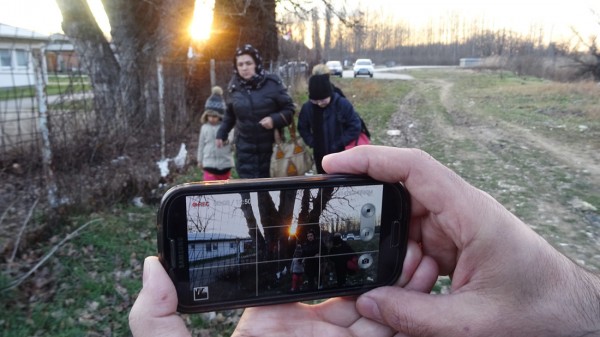
[PREVIEW ONLY]
The long way out, on cell phones
When the Taliban put a bounty price on the Afghan director and "Art Café" owner Hassan Fazili's head, he was forced to flee with his wife and two young daughters. Denied asylum when in Tajikistan, deported back to Afghanistan, they decide fo flee to the West. This is how he shot his two-year journey o Europe with his wife and three young children, using only three cell phones to do the camerawork. The elder of the two girls, Nargis, is full of verve and imagination, wife Fatima Hussaini is a filmmaker too and a tough and vibrant woman. At some point they lose their patience and weep or burst with anger but the children still manage to play and be happy. Iran is a brief relief. Turkey a way-station. Bulgaria is ugly: there are attacks on refugees. A long stay in Serbian camp. (In between countries and camps they're on the run, and they have a horrible experience with a people-smuggler.) Some of the images are beautiful, many hum-drum. Fazili's professionalism and stamina as a filmmaker with such limited means are impressive throughout this long and patient slog. As a Hollywood Reporter review notes, there are lacunae and "seams" showing, and Fazili him self is somewhat absent as a personality.
Midnight Traveler, 90 mins., debuted at Sundance Jan. 2019; also Berlin and CPH:DOX, and the San Francisco International Film Festival, where it was screened for this preview. At the San Francisco awards, Midnight Traveler won the McBaine Documentary Feature Award with a $10,000 cash prize.
SFFILM showtimes:
Wed, Apr 17 at 6:30 pm SFMoMA
Thu, Apr 18 at 3:00 pm Creativity Theater
Fri, Apr 19 at 5:30 pm Berkeley Art Museum/Pacific Film Archive
Last edited by Chris Knipp; 04-22-2019 at 01:28 PM.
-
NILES DAVIS: BIRTH OF THE COOL (Stanley Nelson 2018)
MILES DAVIS: BIRTH OF THE COOL (2018)
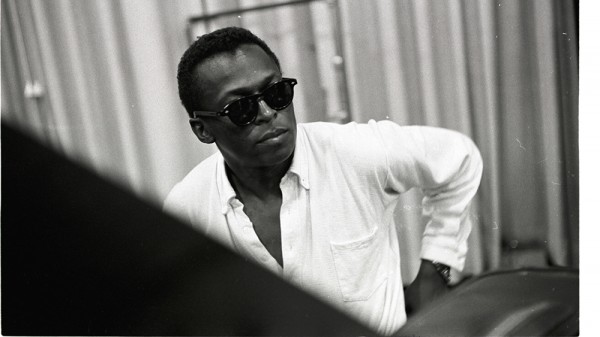
MILES DAVIS IN THE 1960'S
Sketches of Miles
Miles Davis deserves many documentaries. Here is one. That's something. See also Don Cheadle's 2015 feature film recreation Miles Ahead, not a great film maybe, but in the right obnoxious spirit. This one starts off on the wrong foot for me by using a narration of "quotes" from Miles spoken in a fake Miles-gravelly voice by somebody else, leaving one with the distinct initial impression that if the man may have written these words of pedestrian autobiography, he'd never have spoken them. His spoken words had an element of surprise lacking here. Anyway, this is fakery, "simulation."
Nonetheless, when this PBS "Masters" film merely delivers snaps of Miles or clips of the life and the art, they can't be ruined. Simply watch the opening few seconds of a rush of stills of the changing face and variegated styles of the jazz master with "Kind of Blue" playing in the foreground, black and white and sizzling cool, and you're awed. So never mind: this material is golden.
What I didn't know: Miles seems to slide from The Juilliard School into playing with the top jazz artists of Fifth-Second Street without any real stepping stones. Collaborations with Gil Evans begin. He goes to post-liberation Paris in 1949, meets Juliette Greco, and falls madly in love, meeting people like Jean-Paul Sartre through her. Sartre says, "Why don't you marry Juliette Greco?" and Miles replies, "Because I love her." The love lasted a lifetime but failed in the racist USA.
When he returns to New York from the look at another life in Paris, he's so depressed coming "back to the bullshit white people put a black person through in this country" he got addicted to heroin. It's in 1955, age 29, that by failing to stay silent for two weeks after an operation on a polyp on his larynx he got the permanent hoarse gravelly voice everybody identifies with him. His affair with Frances Taylor.
Recounting these things, interesting to know, doesn't convey the electric excitement for a fan of jazz of our glimpses here, stolen moments, if you will, of the great years of Bebop and beyond when "America's classical music" was in flower and Miles Davis was at the heart of it. Listen to how Wayne Shorter and Herbie Hancock, interviewed, describe Miles's sound.
There is a nice account by the pianist (René Urtreger) of the making of Miles' memorable 1957 soundtrack for Louis Malle's Ascenceur pour l'échafaud ("Elevator to the Scaffold"), one of the unique creative jazz sound scores, like the MJQ's stunning score for Roger Vadim's No Sun in Venice from earlier in the same year. The story of the making of the all-time most famous and biggest selling jazz album, the 1959 Kind of Blue. His style: "being cool, and hip, and angry, and sophisticated, and ultra-clean. . . I was all those things." Then, late Sixties, to overcome the dominance of rock, crossover, percussion, new clothes, Bitches Brew "cosmic jungle music." Picasso Miles's continual self-reinvention from then on.
Interlude: 1975-1980 Miles' dark years (referenced in Cheadle's movie) when he did nothing but do drugs and didn't pick up his horn. Rescued by Cicely Tyson. His extraordinary funk rebirth and new personality and constant touring, never looking back, playing only new music, reinvented again, new hip wild look. Then at 65, in 1991, sudden rapid decline.
Miles was a leader in at least five major phases of jazz style, bebop, cool jazz, hard bop, modal jazz, and jazz fusion and three labels, Prestige, Columbia, and Warner Brothers. This film can't begin to cover the many musicians he introduced to the public through new bands. You need a miniseries. There are some good talking heads including Greg Tate, Quincy Jones, Wayne Shorter, Herbie Hancock, George Wein, Frances Taylor, Carlos Santana, Miles 1980's manager Mark Rothbaum, and others, all have interesting things to say. You can never give this subject justice in a couple of hours, but this seems like a fairly good try and the main outlines of the remarkable life and extraordinary art are there.
Birth of the Cool, 115 mins., debuted at Sundance; also Miami, Cleveland and Montclair, as well as San Francisco, where it was screened for this review.
SFFILM showtimes:
Fri, Apr 12 at 5:00 pm BAMPFA
Sun, Apr 14 at 4:00 pm Victoria Theatre

MILES IN HIS SXTIES
Last edited by Chris Knipp; 04-17-2019 at 12:34 AM.
-
MIDNIGHT FAMILY (Luke Lorentzen 2019)
LUKE LORENTZEN: MIDNIGHT FAMILY (2019)
(Originally published for New Directors/New Films)
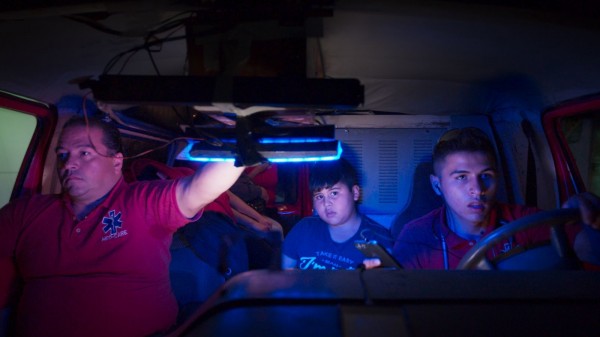
FERNANDO, JOSOÉ AND JUAN ALEXIS OCHOA IN MIDNIGHT FAMILY
Breaking the rules to help people in Mexico City
Partly inspired, Lorentzen says by Harvard’s Sensory Ethnography Lab (Sweetgrass, Foreign Parts, Leviathan, Manakamana), this documentary is an observational and humanistic up close and personal glimpse at people coping with a health care system far worse than that of the US. The place is Mexico City:. The population is nine-million-plus. To serve them the city provides only forty-five ambulances. Private, for profit seat-of-the-pants ambulance services now work competitively to try to fill the gap. Director Luke Lorentzen discovered documentary gold by following one of these. Midnight Family is the prizewinning result.
Lorentzen moved to Mexico City after college with an idea for a film and shifted to this one when he met the Ochoas and they let him ride with them for one night. He spent nearly eighty days filming from two in the afternoon to six or eight in the morning embedded night after night in the private ambulance run by the Ochoa family. He speaks Spanish and worked as a one-man crew using two two Sony FS cameras, one mounted on the roof focusing on the crew in the front window, the other hand held by himself. He shot over a three year period, out with them for a hundred days, though he says that seventy percent of the best material came in the last few days of the shooting.
Lorentzen respects the patients' privacy, but hangs closely with the Ochoas, gaining their confidence for intimate moments. Little, chubby Josoé is lazy and makes excuses not to go to school. Juan is only seventeen, but he drives the vehicle and in all ways is the grownup (though he sleeps in the vehicle curled up with a big fluffy doll). Fer, their father, has a heart condition and sometimes cannot cope. Along with them is Manuel Hernández. There are long waits with nothing happening. There are frantic races to accident sites, speeding through the night streets and crazy Mexico City traffic not only to save the injured but also to beat other private ambulances to the job and the money. But there is not always money even when they get the job. Sometimes their clients are too poor to pay, or just refuse to, and they wind up with an evening's work and no profits, only losses. It's hard at times to see how the Ochoas can even do this job, or afford the equipment. And then there are the cops, who harass them and demand constant bribes, and paperwork, "protocols," a joke since it's all outside the law.
But for Juan, who's muscular and sharp but still wears braces on his teeth, and who enjoys playing to the camera and mouths off with a warm sense of humor, this work is the pleasure of doing good and helping people but also the adrenaline rush of the excitement and struggle to succeed.
This is a human document, but like other good observational films, also a visual treat. Lorenten makes excellent use of the striking night light of the city, the neon glare, the blur, the flashing signals that can make what be drab in daytime into magic. When Midnight Family is operating full-tilt, it's intoxicating to the senses, with the blur and rush of the vehicle, the scream of sirens, and Fer's amplified voice as he uses a loudspeaker to urge people to get out of the way so the ambulance can push through. This is where the Sony cameras pay off with their exceptional capacity to capture in low light. Everything comes together for the filmmaker when he gets dramatic (and beautiful) coverage when the Ochoas rush a girl with a traumatic brain injury and her mother to a private hospital knowing every minute counts to save her, and he captures Juan pacing around and talking to his girlfriend Jessica on the phone later about how this turned out.
The film, which Lorentzen edited as well as shot as a one-man crew, ends beautifully with Fer and Juan picking up Josoé at the schoolyard in the afternoon, then heading out together in the ambulance into the maelstrom of Mexico City traffic at twilight, with the cars' taillights just beginning to glow.
At an appearance in the Guadalajara Festival, Lorentzen said he wanted to show how a good family is forced eventually into corrupt practices because of a broken system and "the corruption is gradually playing with the lives of people, and the Ochoa family is hostage to the police and the health system." But it's a fun watch too - as Lorry Kikta of Film Threat says, "a very exciting, sad, yet extremely funny film."
Midnight Family, 91 mins., debuted at Sundance Jan. 2019 where it won the documentary Special Jury Award for Cinematography. Four other festivals, including the 2019 MoMA-Film Society of Lincoln Center New Directors/New Films series, where it was screened for this review. Many reviews: Metacritic (Metascore 85%), including Nich Schager for Variety. See also a Mexican article about this film.
Midnight Family is also being shown at the 2019 San Francisco Film Festival.
SFFILM showtimes:
Sun, Apr 14 at 2:00 pm Dolby Cinema
Mon, Apr 15 at 3:00 pm SFMOMA Phyllis Wattis Theater
Thu, Apr 18 at 6:00 pm The Theater at Children's Creativity Museum
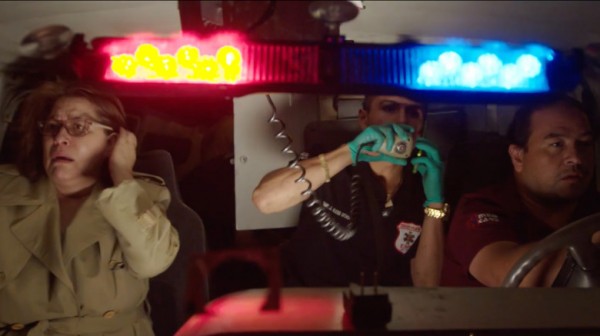
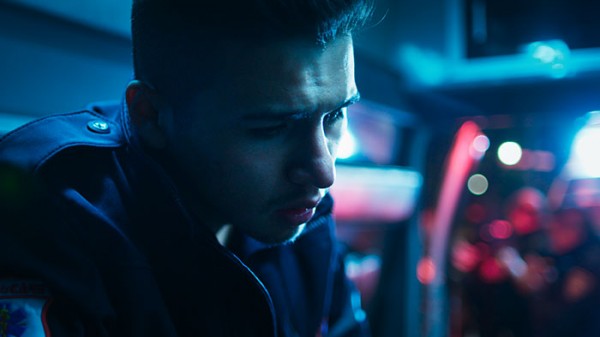
JUAN ALEXIS OCHOA IN MIDNIGHT FAMILY
Last edited by Chris Knipp; 04-15-2019 at 06:38 AM.
 Posting Permissions
Posting Permissions
- You may not post new threads
- You may not post replies
- You may not post attachments
- You may not edit your posts
-
Forum Rules






 Reply With Quote
Reply With Quote









Bookmarks